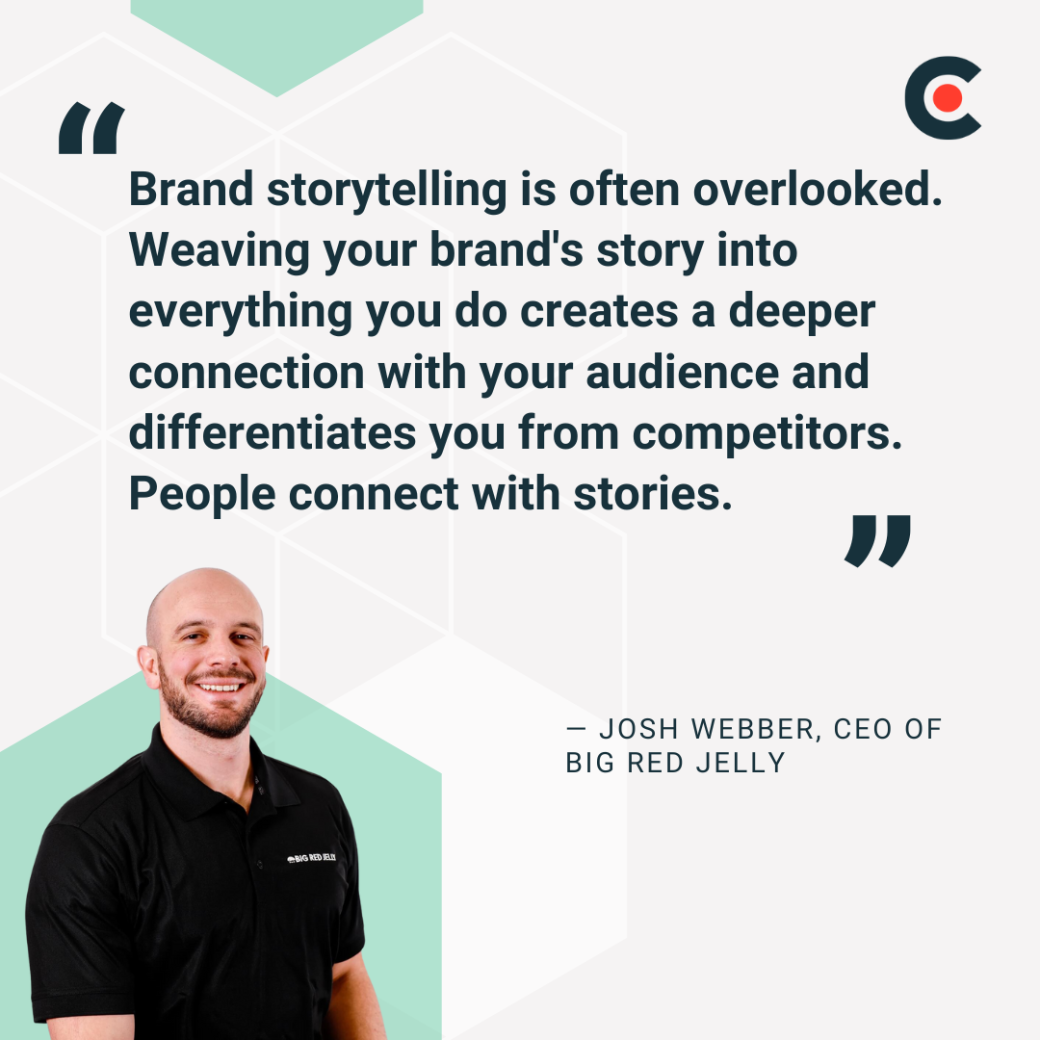

Updated December 18, 2025
Brand identity is more than just a logo. It’s the foundation of how your audience perceives and connects with your business. From creating thorough brand guidelines to crafting compelling messaging, we’ll break down the key content and design tasks to bring your brand to life.
The most memorable brands have a consistent presence wherever you encounter them. Take L.L. Bean, for instance. The clothing retailer’s website is filled with forest green font and nature imagery. Similarly, their Instagram showcases hikers and their pets decked out in L.L. Bean gear. It’s all about shaping the brand’s identity as the go-to choice for outdoor adventurers.
Businesses often focus on creating engaging content, but the presentation is just as important. “Content and design are two sides of the same coin,” explains Josh Webber, CEO of Big Red Jelly. “Design attracts, while content engages. You need both for a lasting impact.”
Looking for a Public Relations agency?
Compare our list of top Public Relations companies near you
Without this careful balance, companies may struggle to stand out. “If one is strong but the other is weak, the brand feels incomplete,” observes Rahul Aswal, Head of Branding & Marketing Consultation at Simple Plan Media. “Visually appealing brands with poor messaging seem hollow, while brands with great copy but weak visuals struggle to attract attention.”
Learn how to develop a brand strategy that combines effective messaging and visuals, and get expert tips for creating cohesive branding.
Developing content is one of the best ways to establish your brand’s identity. Every blog post and Instagram caption influences how your audience perceives you. Use these strategies to tell an engaging and cohesive brand story.
Every communication channel has different formats and norms. Whether you’re using email or TikTok, delivering consistent messaging is critical.
Aswal emphasizes the importance of developing brand guidelines. He explains, “For a brand to establish trust, it needs visual and verbal consistency across all touchpoints. This isn’t possible without well-defined brand guidelines. A strong set of guidelines ensures that no matter where or how a brand appears — whether on social media, packaging, or advertising — it always feels the same, reinforcing recognition and reliability.”
What are brand guidelines, exactly? “A brand guideline document is the culmination of the entire branding process,” explains Aswal. “It should be developed only after all brand assets have been designed. It acts as a brand's playbook, ensuring alignment across teams, agencies, and partners.”
Webber notes that this playbook is especially important when multiple people work on different channels. He says, “These rules prevent brand chaos and ensure everyone’s on the same page.” That way, you won’t have to worry about one person using a serious tone on social media and another making memes.
Start by considering your brand’s mission and purpose. “Define your core values and translate them into visual and verbal elements,” Webber recommends.
According to Aswal, all brand guidelines should include these components:
Focus on making these guidelines clear and accessible. For example, you could include a list of phrases to avoid to help your team master your brand voice. Well-defined guidelines will help them understand the expectations and adapt as needed.
Once you’ve created your brand guidelines, use them to tell meaningful stories about your business. Strong content helps build trust with your audience and allows you to actively shape perceptions of your business rather than leaving it to chance.
Compelling narratives help you stand out, too. “Brand storytelling is often overlooked,” Webber explains. “Weaving your brand's story into everything you do creates a deeper connection with your audience and differentiates you from competitors. People connect with stories.”

Start by choosing two or three types of content to tell your story. Here are several popular options:
As you create these materials, adhere to your guidelines closely. Aswal says, “The Tone of Voice section sets the foundation for all brand communication. By following the brand guidelines, copywriters, marketers, and designers stay aligned, ensuring that everything from a tagline to a press release feels unmistakably ‘on-brand'.”
For example, if your brand persona is casual and humorous, you could post viral skits on TikTok and write pun-filled emails. If you’re going for a more serious tone, you might create educational LinkedIn posts and how-to videos. It’s all about consistency.
You may feel tempted to start churning out content immediately, but you should resist the urge. Instead, take the time to plan a thoughtful content strategy. Otherwise, your online presence might feel chaotic or unpolished, reducing your credibility.
Start by studying your audience. Who are they, and what are their interests? Most importantly, how can you help them improve their lives? Answer these questions by organizing focus groups or surveying your clients. Social media conversations can also provide useful context.
The more data you gather, the easier it is to develop content ideas. As you brainstorm, develop a content calendar to plan when and where you’ll share these materials. For instance, if your audience is interested in industry trends, you could create a series of educational Instagram videos and weekly blogs.
Once you’ve launched your content strategy, use key performance indicators (KPIs) to track your progress. Then, adjust your tactics until you achieve your goals. For example, to increase web traffic, you could use search engine optimization (SEO) techniques to attract visitors.
It’s easy to focus on content, but don’t forget about your visual identity. Leading brands often have a distinct aesthetic that’s instantly memorable. For instance, coffee lovers can spot Starbucks’ green and white logo anywhere. Follow these tips to develop a unified visual identity.
It all starts with a unique logo. This image is the face of your business, so it should create a positive first impression.
“Simplicity, versatility, relevance, timelessness, and uniqueness are key,” Webber advises. “Your logo should stand out and reflect your brand.” Think of symbols that reflect your brand’s goals and mission. For example, if you prioritize sustainability, you might design a nature-themed logo.
However, you also want to be selective about what’s included in your logo. This touches on the “simplicity” Webber mentioned, and Erin Milnes, Account and Creative Director at Catchword Branding agrees. “A good logo expresses one or two ideas at most. Whether it’s a wordmark, an icon, an emblem, or combination, your logo can’t communicate everything about your brand. And it doesn’t have to! I frequently need to remind clients that verbal and visual brand identity are a powerful representation of you, but they don’t tell your whole story. Your company name and logo are supported by marketing, packaging, and other copy and design as well as context.”
Define your color scheme and typography, too. These elements might seem minor, but they help convey specific moods and themes. You should also use a consistent design style and imagery to build familiarity.
Cohesive content is key to improving brand recognition. Coca-Cola is one company that’s mastered this technique. Its signature logo and red color appear on everything from soda cans to Christmas commercials.
Like Coca-Cola, you should use consistent visual elements for all your marketing materials, including:
For example, your packaging and social media posts could use the same typography and color palette. The more you reinforce your brand identity, the faster audiences will recognize it.
Customers may feel confused or mistrustful if your website's aesthetics don't match your other brand assets. Luckily, you can avoid this issue with a consistent, professional design. It’s one of the most effective ways to build credibility.
Always match your website to your brand guidelines. It should have the same visual identity and voice as the rest of your content. That way, customers will immediately know they’re in the right place when they visit your digital storefront.
Accessibility should also be prioritized. Use a mobile-friendly layout that automatically adjusts to different devices. This strategy can also improve your SEO performance, as search engines factor in usability when ranking content.
Of course, your website should also be accessible to people with disabilities. Use colorblind-friendly palettes and add alt-text for all images. These small steps will help everyone navigate your website.
Developing a memorable brand identity involves more than designing a pretty logo or writing a few blog posts. It requires consistent messaging across your content and visuals. If something doesn’t fit your brand guidelines, it doesn’t belong — it's as simple as that.
Once you’ve mastered the basics, it’s time to market your website and test its performance. Sound stressful? You don’t need to do it all alone. Consider partnering with a reputable digital marketing provider to help you track KPIs and fine-tune your approach. And be sure to download our full brand identity checklist for more expert insights and tips.


